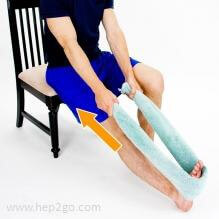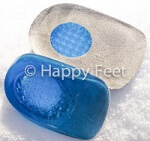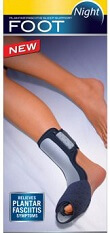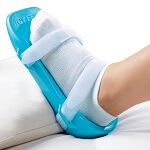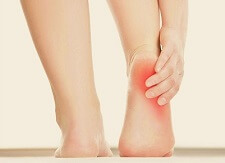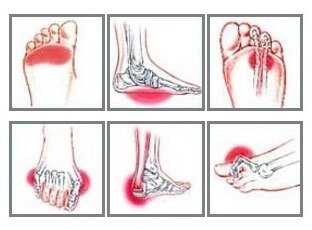- Home
- Common Foot Problems
- Plantar Fasciitis
- PF Treatment
Treatment For Plantar Fasciitis
Written By: Chloe Wilson BSc(Hons) Physiotherapy
Reviewed By: FPE Medical Review Board
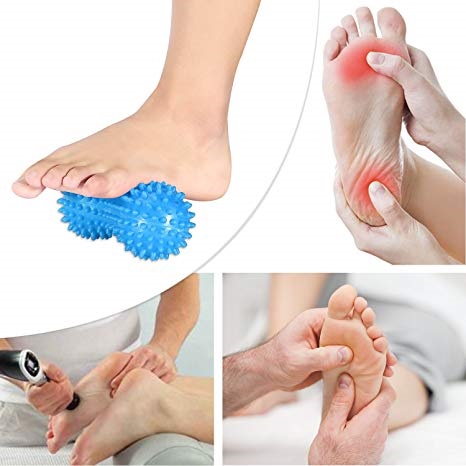
Treatment for plantar fasciitis aims to address both the symptoms and the underlying cause of the disorder.
Plantar Fasciitis is a common cause of pain on the heel and sole of the foot, particularly the first few steps you take after resting.
It is caused by repeated micro-tears of the plantarfascia fibres, most commonly where the fascia attaches to the heel bone. Plantar fasciitis is usually caused by a combination of muscle imbalance, altered foot biomechanics, overuse and poor foot wear.
The sooner people start treatment for plantar fasciitis when their symptoms first appear, the quicker recovery is so it is really important to start treatment quickly. To find out more about the condition, including causes, symptoms and diagnosis, visit the Plantar Fasciitis Overview.
Best Treatment for Plantar Fasciitis
So let's look at the best options for treatment for plantar fasciitis. Most people will use a combination of:
1. Stretching Exercises
Tightness of the calf muscles is one of the most common causes of plantar fasciitis as it places excessive tension on the plantar fascia. This makes stretching exercises an invaluable treatment for plantar fasciitis.
Stretches should target both the calf and the plantar fascia itself to be most effective. Visit the Plantar Fasciitis Stretching Exercises section for five simple and effective stretches.
2. Strengthening Exercises
Strengthening exercises targeting the intrinsic muscles of the foot and the calf muscles are a great treatment for plantar fasciitis as they help to stabilize and support the foot and heel.
Strengthening exercises should be done daily and as with all plantar fasciitis treatments, the sooner they are started after symptoms begin, the shorter the recovery time. Visit the plantar fasciitis strengthening exercises section to find out more.
3. Shoe Inserts/Orthotics
Inserts for your shoes are another simple yet extremely effective treatment for plantar fasciitis. They vary from simple heel pads/cups that provide cushioning for the heel and reduce the tension going through the Achilles tendon and plantar fascia, to custom made orthotics to correct abnormal foot position such as fallen arches.
Visit the Orthotics for Plantar Fasciitis section to compare different products and read user reviews.
4. Appropriate Rest
You will need to rest from all activities that are aggravating your heel pain to allow time for your plantar fasciitis to heal. If you keep aggravating the plantar fascia, recovery will take much longer as more micro-tears will develop.
This does not mean you need to take to your bed until you are pain-free but certainly avoid any sporting activities such as running that aggravate your plantar fasciitis and instead try other forms of cardiovascular exercise such as swimming or cycling.
Plantar fasciitis pain is typically worse after prolonged periods of rest e.g. overnight, as the fascia tightens and shortens, and it is the most common cause of foot pain in the morning.
5. Night Splints
You can get special splints and socks that are a great treatment for plantar fasciitis. They are worn in bed and pull up the toes and foot to apply and maintain a gentle stretch on the plantar fascia. Most of us sleep with our feet pointing down which places the plantar fascia in a shortened position, making it prone to tightness.
Night splints are a great treatment for plantar fasciitis without taking much effort and often helps eradicate the pain that is usually felt during your first few steps each morning. Find out more about the different types of night splints in the Orthotics for Plantar Fasciitis section.
6. Footwear
You want to wear shoes that provide good cushioning and support with plantar fasciitis, especially for the medial arch of the foot. Shoes get less effective at shock absorption with time so should be changed regularly. It can also help to wear shoes all day rather than going bare-foot to ensure the foot is getting support and cushioning at all times.
7. Ice Treatment
Ice is a great treatment for plantar fasciitis for reducing pain and
inflammation. There are a number of different ways to ice the foot:
- Icy Feet: This is a specially designed ice pack that is
strapped to the foot. It is contoured to the shape of the foot with a
recessed heel cup and elevated arch to ensure continuous ice contact
through the whole foot. You can find out more about IcyFeet and read
reviews of this neat ice treatment for plantar fasciitis
- Ice Pack: Whether you wrap ice in a towel, use frozen peas or have a specially designed ice pack, apply ice for ten to fifteen minutes to the sole of the foot at a time. Always make sure it is wrapped in a towel to prevent the risk of ice burn
- Ice Massage: a simple option is to massage the foot with an ice cube, moving it in circles around the sole of the foot. Another way to do this is to freeze a cup of water (filled to the top) and use that. As it melts, you can peel back the sides of the cup. It is very important to keep the ice moving to prevent the risk of an ice burn
You can find out more about how to use ice safely and effectively in the Ice Treatment section.
8. Medication
Your doctor may advise non-steroidal anti-inflammatories (NSAIDs) such as Ibuprofen or Advil to help reduce pain and inflammation as part of your treatment for plantar fasciitis. Always consult your doctor before taking any medications.
9. Injections
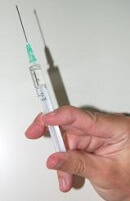
Corticosteroid injections are a commonly used treatment for plantar fasciitis to reduce pain and inflammation if conservative treatment such as exercises and splints are not being effective. Injections should only ever be administered by a trained professional.
Care must be taken for the first few days following an injection for plantar fasciitis as the tendon is temporarily weakened so is at risk of rupture. Repeated doses should also be avoided to prevent long-term weakening – a maximum of three injections per year. Benefits may only be short lived and injections should not be used in isolation but alongside other plantar fasciitis treatments.
You can find out more about how steroid injections work on our sister site.
10. Plantar Fasciitis Surgery
Although a last resort, approximately five percent of people end up needing plantar fasciitis surgery when other treatment methods have failed to work after six to twelve months. Surgery involves releasing the plantar fascia tension by cutting through part of the fascia and smoothing down any bone spurs on the heel that have formed.
You may have to wear a cast and be non-weight bearing for a couple of weeks depending on how the plantar fasciitis surgery is performed. Rehab will consist of strengthening and stretching exercises and running and jumping should be avoided for at least three months.
Can Plantar Fasciitis Heal Itself?
Yes, plantar fasciitis is a self-limiting condition, meaning that it should eventually get better even without treatment, although it can take eighteen months.
However, effective, targeted treatment for plantar fasciitis can make a huge difference, speeding up recovery and reducing the risk of the condition returning at a later date. Delaying treatment will lead to a much longer overall recovery time.
What Else Can Help?
You can find out more about these different options for treatment for plantar fasciitis by clicking on the links above. Remember, the sooner you start treating plantar fasciitis the quicker you will recover so don’t delay, start today!
Visit the plantar fasciitis overview for more information about the condition including common causes, symptoms and diagnosis, as well as how to prevent the condition from returning.
Whilst plantar fasciitis is the most common cause of heel pain, there are a number of other causes including Achilles Tendonitis, bursitis and Severs Disease. Visit the Heel Pain Diagnosis section for help working out what is causing your heel pain.
Related Articles
Page Last Updated: 05/13/23
Next Review Due: 05/13/25
- Home
- Treatment Guide
- PF Treatment
